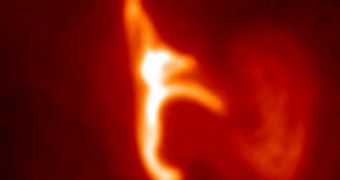Most of us will probably never understand the true power of the Sun. Three thousand degrees Celsius or three million degrees do not make any difference to the average person, because one could never experience temperatures of this magnitude. And even if s/he experienced, s/he would never share his experience with anybody afterwards. Solar flares are extremely hot, exceeding temperatures of several tens of millions of degrees Celsius; however NASA researchers now reveal that they can get even hotter when they are focused.
Dr. Ryan Milligan of the Oak Ridge Association of Universities and NASA Goddard Space Flight Center investigator explains: "A flare typically divides its energy between directly heating the solar atmosphere and accelerating particles. This flare seems to focus on one task, devoting all its energy to heating, allowing it to become millions of degrees hotter that its multi-tasking cousins."
The results of the study conducted by Dr Milligan were presented yesterday at the Royal Astronomical Society's National Astronomy Meeting, taking place at Queen's University, Belfast.
Solar flares, as much as most of the solar activity, are driven by the Sun's magnetic field. The energy released during the formation of such a solar flare can easily exceed a billion megaton nuclear bomb and emit dangerous radiation in the form of solar wind, hazardous both for the life in Earth's orbit and for that on the surface.
Plasma gas is picked up and shaped by the powerful magnetic fields of the Sun into loops rising high above the surface of the Sun. Plasma is generally a good electrical conductor, thus these loops are most likely a conducting path for electrons moving from one side of the solar surface towards the other. However, this electron movement through the solar flare loops causes even more plasma to be evaporated from the surface of the Sun, thus expanding the solar flare.
"This evaporated plasma had traditionally been believed to be the source of the hottest temperatures seen in the solar flare. However, the flare in this new observation reached a temperature of almost 15 million degrees Celsius - some five million degrees hotter than expected for a flare of this size - without any evidence for beams of accelerated electrons," said Milligan.
Observations were conducted with the Reuven Ramaty High Energy Solar Spectroscopic Imager and the Hinode spacecraft during 7 June 2007. The solar flare did not present any evidence of high-energy electrons, but it looked like it was releasing energy through most of the layers of the solar atmosphere.
Milligan concludes: "If our assumption is correct, then this result tells us that the energy released during a solar flare is more efficient at achieving a higher temperature if the energy is used to directly heat the plasma in the Sun's atmosphere, instead of being divided between heating and particle acceleration. This very effect had recently been shown in computer simulations of energy release during microflares."

 14 DAY TRIAL //
14 DAY TRIAL //